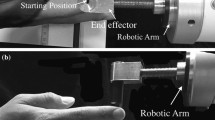Abstract
The aim of this investigation was to determine whether age-related changes in the dynamics of muscle activation were, in part, responsible for longer reaction times (RT) in the elderly. A group of 12 young (mean age, 20.6 years) and 12 elderly (mean age, 64.3 years) women performed a series of ballistic forearm supination movements in response to an auditory stimulus while using a simple reaction time test. Surface electromyographic waveforms from biceps brachii (agonist) and pronator teres (antagonist) muscles were recorded, together with the angle-time curves representing the motion of the forearm, on to an IBM compatible microcomputer. The results showed that an age-related increase (P<0.05) in motor reaction time (MRT) contributed to longer RT in the elderly. In addition, the longer (P<0.05) MRTs in the elderly were associated with a significantly slower rate (P<0.05) of biceps brachii muscle activation and a significantly increased proportion (P<0.05) of the initial biceps brachii muscle burst required to initiate the movement. This data suggested that an important part of the slowing of motor behaviour, commonly observed with increasing age, may be due to either decreases in the ability of aged skeletal muscle to rapidly generate tension or to a reduction in motor drive.
Similar content being viewed by others
References
Baylor AM, Spirduso WW (1988) Systemic aerobic exercise and components of reaction time in older women. J Gerontol Psychol Sci 43:121–126
Birren JE, Botwinick J (1955) Age differences in finger, jaw, and foot reaction time to auditory stimuli. J Gerontol 10:429–432
Brown WF (1972) A method for estimating the number of motor units in the thenar muscle and the changes in motor unit count with ageing. J Neurol Neurosurg Psychiatry 35:845–852
Buell SJ, Coleman PD (1979) Dendritic growth in the aged human brain and failure of growth in senile dementia. Science 206:854
Campbell MJ, McComas AJ, Petito F (1973) Physiological changes in ageing muscles. J Neurol Sci 36:174–182
Cavanagh PR, Komi PV (1979) Electromechanical delay in human skeletal muscle under concentric and eccentric contractions. Eur J Appl Physiol 42:159–163
Chambers WP, Dunihue PN, Smith CJ, Blanchard RR, Taylor CH, Hill DB (1966) Effect of vasopressin and adrenal steroids on cortical responses evoked at midbrain level in aged rats. Gerontologia 12:43–61
Clarkson PM (1978) The effect of age and activity level on simple and choice fractionated response time. Eur J Appl Physiol 40:17–25
Dorfman LJ, Bosley TM (1979) Age-related changes in peripheral and central nerve conduction in man. Neurology (Minneapolis) 29:78–93
Era P, Jokela J, Heikkinen E (1986) Reaction and movement times in men of different ages: a population study. Percept Mot Skills 63:111–130
Finch CE (1976) The regulation of physiological changes during mammalian aging. Q Rev Biol 51:49–83
Gutmann E (1977) Muscle. In: Finch CE, Hayflick L (eds) Handbook of the biology of ageing. Van Nostrand Reinhold, New York, pp 445–469
Ito H, Nagasaki H, Hashizume K, Maruyama H, Nakamura R (1990) Time-course of force production by fast isometric contraction of the knee extensor in young and elderly subjects. J Hum Ergol 19:23–29
Larish DD, Stelmach GE (1982) Preprogramming, programming and reprogramming of aimed hand movements as a function of age. J Mot Behav 14:322–340
Larsson L, Grimby G, Karlsson J (1979) Muscle strength and speed of movement in relation to age and muscle morphology. J Appl Physiol 46:451–456
McCarter R (1978) Effects of age on contraction of mammalian skeletal muscle. In: Kaldor G, Battista WJ (eds) Aging. Raven Press, New York, 6, 1-7
McGeer PL, McGeer EG, Suzuki JS (1977) Ageing and extrapyramidal function. Arch Neurol 34:73–97
Mero A, Komi PV (1990) Reaction time and electromyographic activity during a sprint start. Eur J Appl Physiol 61:73–80
Rikli R, Busch S (1986) Motor performance of women as a function of age and physical activity level. J Gerontol 41:645–649
Sage GH (1984) Motor learning and control: a neuropsychological approach. Brown, Dubuque, Iowa, pp 218–227
Schmidt RA (1988) Motor control and learning: a behavioral emphasis (2nd edn) Human Kinetics Champaign, Ill., pp 336–338
Seeley RR, Stephens TD, Tate P (1989) Anatomy and physiology. Times Mirror/Mosby College Publishing, St. Louis, Mo., pp 257–259
Smith DO (1979) Reduced capabilities of synaptic transmission in aged rats. Exp Neurol 66:650–666
Spirduso WW (1975) Reaction and movement time as a function of age and physical activity level. J Gerontol 35:850–865
Spirduso WW, Clifford P (1978) Replication of age and physical activity effects on reaction and movement time. J Gerontol 33:26–30
Stelmach GE, Amrhein PC, Goggin NL (1988) Age differences in bimanual coordination. J Gerontol 43:18–23
Teravainen H, Calne DB (1983) Motor system in normal ageing and Parkinson's disease. In. Katzman R, Terry R (eds) Neurology of ageing. Davis, Philadelphia, Pa, pp 85–109
Tomanoga M (1977) Histochemical and ultrastructural changes in senile human skeletal muscle. J Am Geront Soc 25:125–131
Vijayashanker N, Brody H (1979) A quantitative study of the pigmented neurons in the nucleus locus coeruleus and subcoeruleus in man as related to ageing. J Neuropathol Exp Neurol 38:490
Weiss AD (1965) The locus of reaction time change with set, motivation, and age. J Geront 20:60–64
Author information
Authors and Affiliations
Rights and permissions
About this article
Cite this article
Lewis, R.D., Brown, J.M.M. Influence of muscle activation dynamics on reaction time in the elderly. Eur J Appl Physiol 69, 344–349 (1994). https://doi.org/10.1007/BF00392041
Accepted:
Issue Date:
DOI: https://doi.org/10.1007/BF00392041




